Study of Energy Valorization of Disposable Masks via Thermochemical Processes: Devolatilization Tests and Simulation Approach
Abstract
1. Introduction
- Physicochemical characterization of selected materials.
- Devolatilization tests of the characterized materials at semi-batch lab-scale apparatus that allows a fast determination of gas-phase composition in terms of permanent gas (H2, CO, CO2, CH4).
2. Materials and Methods
2.1. Materials for Devolatilization Tests
2.2. Materials Characterization
2.3. Devolatilization Tests: Experimental Plan and Layout
2.4. Devolatilization Tests: Reaction Section
2.5. Devolatilization Tests: Data Processing
- gas yield (ηav, Equation (4)) (mol/100 g sample);
- carbon conversion (χav,C, Equation (5)) (g/g);
- outlet H2/CO ratio (, Equation (6)) (mol/mol);
- percentage of i on dry and dilution free basis (Yav,i, Equation (7)) (mol/mol).
2.6. Modeling Approach
3. Results and Discussion
3.1. Results of Physic-Chemical Characterization of FFP2 and Chirurgical Masks
3.2. Results of Devolatilization Tests
- In a nitrogen atmosphere, there is a small number of oxidized compounds compared to CH4 and H2. This is justified by the fact that, as discussed for the characterization test, disposable face masks contain mainly polypropylene and polyethylene consisting of long chains of hydrocarbons (HCs). On the other hand, the small amount of oxygen developed is mainly attributable to the presence of other unidentified components constituting the filter layers and the small amount (corresponding to the volume between the two feeding valves) of air that inevitably enters the reactor during sample loading.
- When air is added to the inlet gas mixture, there is a greater development of oxidized compounds (CO and CO2) that increase with the increasing of temperature. A slow development of a CO2 bell-shaped curve can be observed, in particular, at high temperatures when more gas is produced. The CO2 curve takes more time than the others to return to zero.
- For each operating condition, as the temperature increases, syngas composition changes: CH4 develops mainly at low temperatures, whereas H2 at high temperatures; this is due to the higher decomposition that takes place at a higher temperature.
- Some of the carbon is collected during the condensable capture process.
- During the testing campaign, the rapid condensation of gaseous products, which are exposed to room temperature both on the reactor head and in the piping before the condensation zone, results in a very viscous residue in pipes, like TAR, which causes blackening and obstruction.
3.3. Results from GC-MS
3.4. Simulations Results
4. Conclusions
Author Contributions
Funding
Data Availability Statement
Acknowledgments
Conflicts of Interest
Appendix A
| Temperature | Sample | ηav (mol/100 gsample) | H2/CO | YavH2 (%mol N2 free) | YavCO (%mol N2 free) | YavCO2 (%mol N2 free) | YavCH4 (%mol N2 free) | χav |
|---|---|---|---|---|---|---|---|---|
| 500 °C | Chirurgical | 1.41 | 10.20 | 27% | 3% | 3% | 67% | 15% |
| FFP2 | 1.33 | 5.39 | 26% | 6% | 7% | 61% | 15% | |
| 600 °C | Chirurgical | 2.02 | 21.67 | 37% | 2% | 2% | 60% | 15% |
| FFP2 | 2.20 | 10.34 | 38% | 4% | 4% | 54% | 20% | |
| 700 °C | Chirurgical | 2.96 | 22.46 | 58% | 3% | 0% | 39% | 19% |
| FFP2 | 3.83 | 17.15 | 58% | 4% | 3% | 35% | 24% | |
| 800 °C | Chirurgical | 5.27 | 9.27 | 71% | 8% | 1% | 20% | 22% |
| FFP2 | 5.02 | 9.28 | 71% | 9% | 1% | 18% | 22% |
| Temperature | Sample | ηav (mol/100 gsample) | H2/CO | YavH2 (%mol N2 free) | YavCO (%mol N2 free) | YavCO2 (%mol N2 free) | YavCH4 (%mol N2 free) | χav |
|---|---|---|---|---|---|---|---|---|
| 500 °C | Chirurgical | 1.74 | 2.10 | 19% | 9% | 23% | 49% | 20% |
| FFP2 | 1.56 | 2.18 | 20% | 9% | 22% | 49% | 19% | |
| 600 °C | Chirurgical | 2.51 | 2.88 | 26% | 9% | 23% | 41% | 27% |
| FFP2 | 2.31 | 3.03 | 29% | 9% | 18% | 44% | 24% | |
| 700 °C | Chirurgical | 4.90 | 5.28 | 46% | 9% | 18% | 27% | 38% |
| FFP2 | 4.43 | 5.68 | 48% | 9% | 18% | 26% | 34% | |
| 800 °C | Chirurgical | 7.16 | 5.91 | 60% | 11% | 13% | 17% | 43% |
| FFP2 | 5.80 | 6.20 | 62% | 10% | 10% | 17% | 33% |
| Temperature | Sample | ηav (mol/100 gsample) | H2/CO | YavH2 (%mol N2 free) | YavCO (%mol N2 free) | YavCO2 (%mol N2 free) | YavCH4 (%mol N2 free) | χav |
|---|---|---|---|---|---|---|---|---|
| 500 °C | Chirurgical | 1.37 | 1.77 | 21% | 13% | 21% | 45% | 16% |
| FFP2 | 1.60 | 1.41 | 22% | 16% | 21% | 41% | 18% | |
| 600 °C | Chirurgical | 2.27 | 2.56 | 29% | 12% | 13% | 46% | 23% |
| FFP2 | 2.88 | 1.76 | 26% | 15% | 19% | 40% | 32% | |
| 700 °C | Chirurgical | 5.28 | 4.73 | 47% | 10% | 13% | 30% | 42% |
| FFP2 | 5.33 | 4.35 | 44% | 10% | 20% | 26% | 44% | |
| 800 °C | Chirurgical | 5.99 | 7.65 | 61% | 8% | 12% | 19% | 34% |
| FFP2 | 4.97 | 5.15 | 55% | 11% | 17% | 18% | 34% |
Appendix B
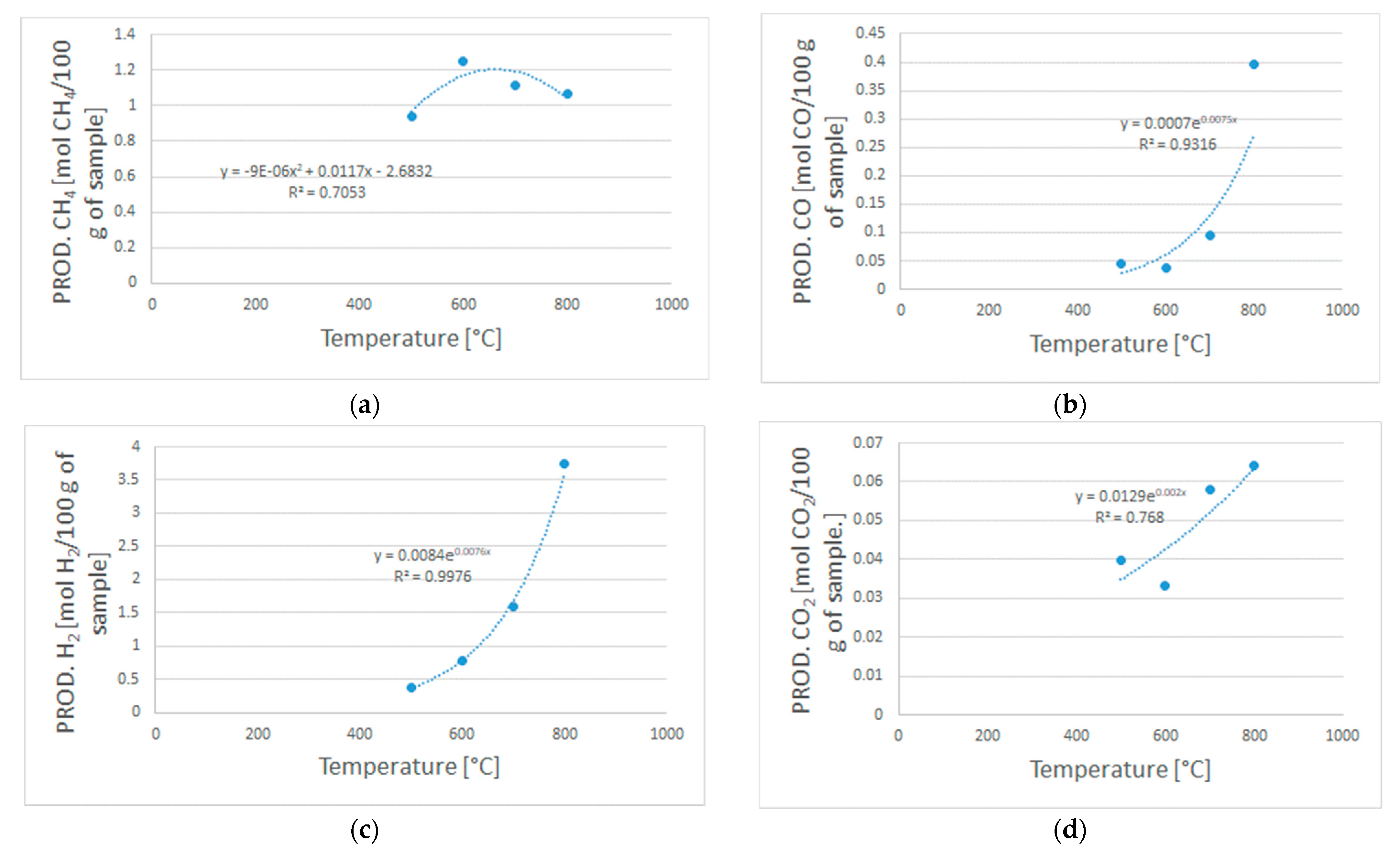
References
- Malinauskaite, J.; Jouhara, H. The trilemma of waste-to-energy: A multi-purpose solution. Energy Policy 2019, 129, 636–645. [Google Scholar] [CrossRef]
- Siwal, S.S.; Chaudhary, G.; Saini, A.K.; Kaur, H.; Saini, V.; Mokhta, S.K.; Chand, R.; Chandel, U.K.; Christie, G.; Thakur, V.K. Key ingredients and recycling strategy of personal protective equipment (PPE): Towards sustainable solution for the COVID-19 like pandemics. J. Environ. Chem. Eng. 2021, 9, 106284. [Google Scholar] [CrossRef] [PubMed]
- Centi, G.; Perathoner, S. Chemistry and energy beyond fossil fuels. A perspective view on the role of syngas from waste sources. Catal. Today 2020, 342, 4–12. [Google Scholar] [CrossRef]
- Sebastiani, A.; Macrì, D.; Gallucci, K.; Materazzi, M. Steam-oxygen gasification of refuse derived fuel in fluidized beds: Modelling and pilot plant testing. Fuel Process. Technol. 2021, 216, 106783. [Google Scholar] [CrossRef]
- Siwal, S.S.; Zhang, Q.; Devi, N.; Saini, A.K.; Saini, V.; Pareek, B.; Gaidukovs, S.; Thakur, V.K. Recovery processes of sustainable energy using different biomass and wastes. Renew. Sustain. Energy Rev. 2021, 150, 111483. [Google Scholar] [CrossRef]
- Green Energy: From Waste to Syngas Production—Instrumentation Monthly. Available online: https://www.instrumentation.co.uk/green-energy-from-waste-to-syngas-production/ (accessed on 28 June 2021).
- De-la-Torre, G.E.; Aragaw, T.A. What we need to know about PPE associated with the COVID-19 pandemic in the marine environment. Mar. Pollut. Bull. 2021, 163, 111879. [Google Scholar] [CrossRef]
- Parku, G.K.; Collard, F.; Görgens, J.F. Pyrolysis of waste polypropylene plastics for energy recovery: In fl uence of heating rate and vacuum conditions on composition of fuel product. Fuel Process. Technol. 2020, 209, 106522. [Google Scholar] [CrossRef]
- Ahmad, I.; Khan, M.I.; Khan, H.; Ishaq, M.; Tariq, R.; Gul, K.; Ahmad, W. Pyrolysis study of polypropylene and polyethylene into premium oil products. Int. J. Green Energy 2015, 12, 663–671. [Google Scholar] [CrossRef]
- Hou, Q.; Zhen, M.; Qian, H.; Nie, Y.; Bai, X.; Xia, T.; Laiq Ur Rehman, M.; Li, Q.; Ju, M. Upcycling and catalytic degradation of plastic wastes. Cell Rep. Phys. Sci. 2021, 2, 100514. [Google Scholar] [CrossRef]
- Hou, Q.; Qi, X.; Zhen, M.; Qian, H.; Nie, Y.; Bai, C.; Zhang, S.; Bai, X.; Ju, M. Biorefinery roadmap based on catalytic production and upgrading 5-hydroxymethylfurfural. Green Chem. 2021, 23, 119–231. [Google Scholar] [CrossRef]
- Huang, F.; Li, W.; Hou, Q.; Ju, M. Enhanced CH4 production from corn-stalk pyrolysis using Ni-5CeO2/MCM-41 as a catalyst. Energies 2019, 12, 774. [Google Scholar] [CrossRef]
- GSTC. Waste to Energy Gasification; GSTC. Available online: https://globalsyngas.org/syngas-technology/syngas-production/waste-to-energy-gasification/ (accessed on 6 April 2021).
- Puig-Arnavat, M.; Bruno, J.C.; Coronas, A. Review and analysis of biomass gasification models. Renew. Sustain. Energy Rev. 2010, 14, 2841–2851. [Google Scholar] [CrossRef]
- González-Vázquez, M.P.; Rubiera, F.; Pevida, C.; Pio, D.T.; Tarelho, L.A.C. Thermodynamic analysis of biomass gasification using aspen plus: Comparison of stoichiometric and non-stoichiometric models. Energies 2021, 14, 189. [Google Scholar] [CrossRef]
- Galvagno, A.; Prestipino, M.; Chiodo, V.; Maisano, S.; Brusca, S.; Lanzafame, R. Biomass blend effect on energy production in a co-gasification-CHP system. AIP Conf. Proc. 2019, 2191, 020082. [Google Scholar] [CrossRef]
- Tauqir, W.; Zubair, M.; Nazir, H. Parametric analysis of a steady state equilibrium-based biomass gasification model for syngas and biochar production and heat generation. Energy Convers. Manag. 2019, 199, 111954. [Google Scholar] [CrossRef]
- Kaushal, P.; Tyagi, R. Advanced simulation of biomass gasification in a fluidized bed reactor using ASPEN PLUS. Renew. Energy 2017, 101, 629–636. [Google Scholar] [CrossRef]
- George, J.; Arun, P.; Muraleedharan, C. Stoichiometric Equilibrium Model Based Assessment of Hydrogen Generation through Biomass Gasification. Procedia Technol. 2016, 25, 982–989. [Google Scholar] [CrossRef]
- De Kam, M.J.; Morey, R.V.; TIffany, D.G. Integrating biomass to produce heat and power at ethanol plants. Appl. Eng. Agric. 2009, 25, 227–244. [Google Scholar] [CrossRef][Green Version]
- Haydary, J. Aspen simulation of two-stage pyrolysis/gasification of carbon based solid waste. Chem. Eng. Trans. 2018, 70, 1033–1038. [Google Scholar] [CrossRef]
- Khuriati, A.; Purwanto, P.; Setiyo Huboyo, H.; Suryono, S.; Bawono Putro, A. Application of aspen plus for municipal solid waste plasma gasification simulation: Case study of Jatibarang Landfill in Semarang Indonesia. J. Phys. Conf. Ser. 2018, 1025, 012006. [Google Scholar] [CrossRef]
- Mutlu, Ö.Ç.; Zeng, T. Challenges and Opportunities of Modeling Biomass Gasification in Aspen Plus: A Review. Chem. Eng. Technol. 2020, 43, 1674–1689. [Google Scholar] [CrossRef]
- Gagliano, A.; Nocera, F.; Bruno, M.; Cardillo, G. Development of an Equilibrium-based Model of Gasification of Biomass by Aspen Plus. Energy Procedia 2017, 111, 1010–1019. [Google Scholar] [CrossRef]
- Salman, C.A.; Omer, C.B. Process modelling and simulation of waste gasification-based flexible polygeneration facilities for power, heat and biofuels production. Energies 2020, 13, 4264. [Google Scholar] [CrossRef]
- Beheshti, S.M.; Ghassemi, H.; Shahsavan-Markadeh, R. Process simulation of biomass gasification in a bubbling fluidized bed reactor. Energy Convers. Manag. 2015, 94, 345–352. [Google Scholar] [CrossRef]
- Pauls, J.H.; Mahinpey, N.; Mostafavi, E. Simulation of air-steam gasification of woody biomass in a bubbling fluidized bed using Aspen Plus: A comprehensive model including pyrolysis, hydrodynamics and tar production. Biomass Bioenergy 2016, 95, 157–166. [Google Scholar] [CrossRef]
- Aspen Plus v 12.0. Available online: https://www.aspentech.com/en/-/media/aspentech/home/support-and-training/deployment-solutions/aspenone-v12-getting-started-guide.pdf?la=en (accessed on 8 February 2021).
- Ffp2—All Medical Device Manufacturers. Available online: https://www.medicalexpo.com (accessed on 18 February 2022).
- Jung, S.; Lee, S.; Dou, X.; Kwon, E.E. Valorization of disposable COVID-19 mask through the thermo-chemical process. Chem. Eng. J. 2021, 405, 126658. [Google Scholar] [CrossRef] [PubMed]
- Abraham, J.P.; Plourde, B.D.; Cheng, L. Using heat to kill SARS-CoV-2. Rev. Med. Virol. 2020, 30, 8–10. [Google Scholar] [CrossRef]
- Solid Recovered Fuels. Determination of Moisture Content Using The Oven Dry Method. Moisture in General Analysis Sample. 2011. Available online: https://www.iso.org/standard/71327.html (accessed on 18 February 2021).
- The British Standards Institution Methods for Analysis and Testing of Coal and Coke (Multi-Part Document BS 1016) 2022. Available online: https://landingpage.bsigroup.com/LandingPage/Series?UPI=BS%201016 (accessed on 18 February 2022).
- ASTM International Standard Test Method for Compositional Analysis by Thermogravimetry 2003. Available online: https://standards.globalspec.com/std/14182172/ASTM%20E1131-20 (accessed on 18 February 2021).
- Gutierrez, A.C.G. Characterization of the Fuel Fraction of Solid Urban Solid Wastes of the Municipality of Santo André Aiming.
- UNI CEN/TS 15439:2008 Biomass Gasification. Tar and Particles in Product Gases. Sampling and Analysis 2008. Available online: https://www.uni.com/ (accessed on 8 February 2021).
- Gibilaro, L.G. Fluidization Dynamics. Butterworth Heinemann: Oxford, UK, 2011; ISBN 0750650036. [Google Scholar]
- Yang, W. Handbook of Fluidization and Fluid-Particle Systems; CRC Press: Boca Raton, FL, USA, 2003. [Google Scholar]
- Malsegna, B.; Di Giuliano, A.; Gallucci, K. Experimental study of absorbent hygiene product devolatilization in a bubbling fluidized bed. Energies 2021, 14, 2399. [Google Scholar] [CrossRef]
- Ramzan, N.; Ashraf, A.; Naveed, S.; Malik, A. Simulation of hybrid biomass gasification using Aspen plus: A comparative performance analysis for food, municipal solid and poultry waste. Biomass Bioenergy 2011, 35, 3962–3969. [Google Scholar] [CrossRef]
- Basu, P. Biomass Gasification, Pyrolysis and Torrefaction: Practical Design and Theory; Academic Press: Cambridge, MA, USA, 2013; ISBN 9780123964885. [Google Scholar]
- Basu, P. Combustion and Gasification in Fluidized Beds; CRC Press: Boca Raton, FL, USA, 2006; ISBN 9780849333965. [Google Scholar]
- Zaror, C.A.; Pyle, D.L. The pyrolysis of biomass: A general review. Proc. Indian Acad. Sci. Sect. C Eng. Sci. 1982, 5, 269–285. [Google Scholar] [CrossRef]
- Aragaw, T.A. Surgical face masks as a potential source for microplastic pollution in the COVID-19 scenario. Mar. Pollut. Bull. 2020, 159, 111517. [Google Scholar] [CrossRef] [PubMed]
- Di Giuliano, A.; Lucantonio, S.; Gallucci, K. Devolatilization of residual biomasses for chemical looping Gasification in Fluidized Beds Made up of Oxygen-Carriers. Energies 2021, 14, 311. [Google Scholar] [CrossRef]
- Xiao, R.; Jin, B.; Zhou, H.; Zhong, Z.; Zhang, M. Air gasification of polypropylene plastic waste in fluidized bed gasifier. Energy Convers. Manag. 2007, 48, 778–786. [Google Scholar] [CrossRef]
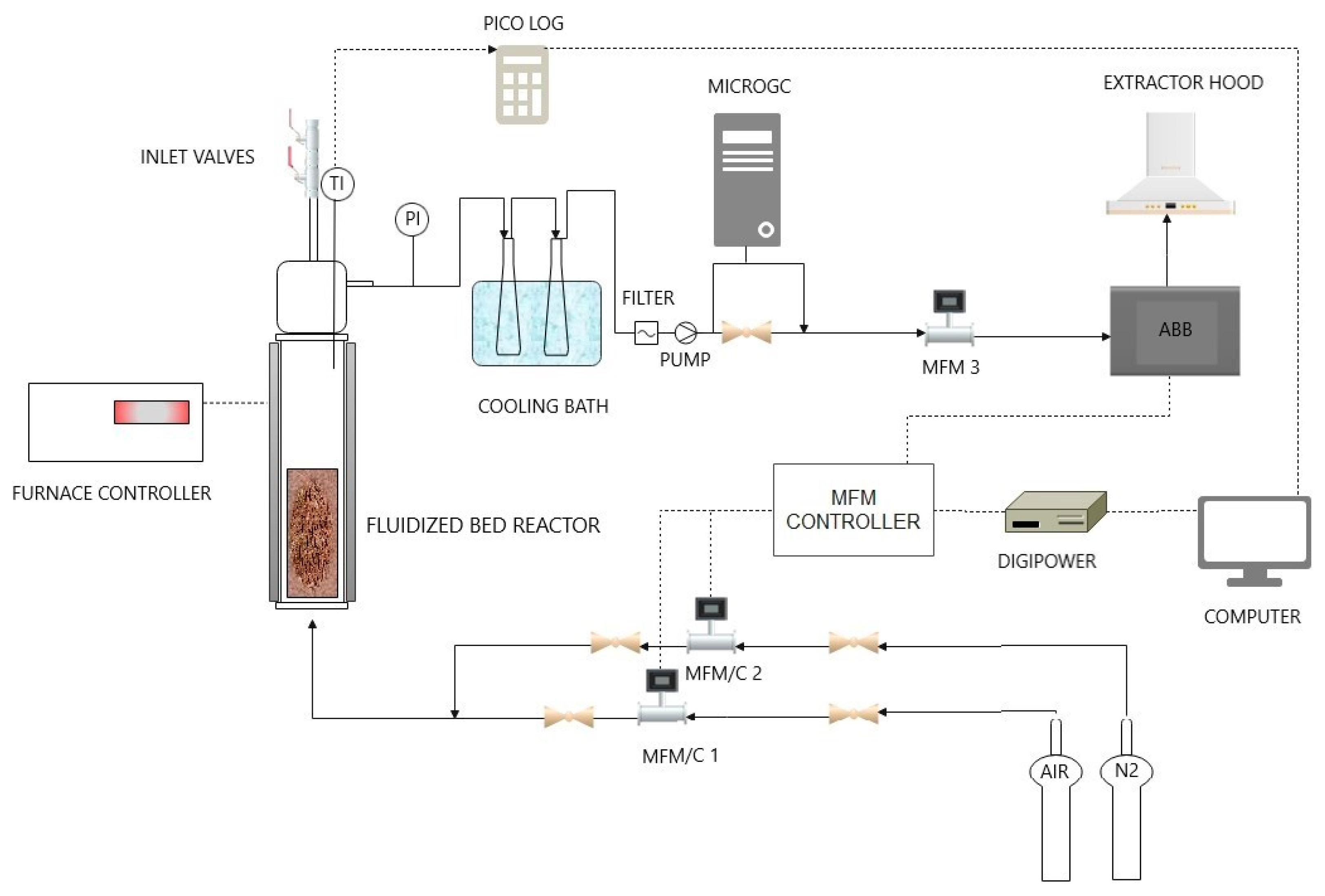
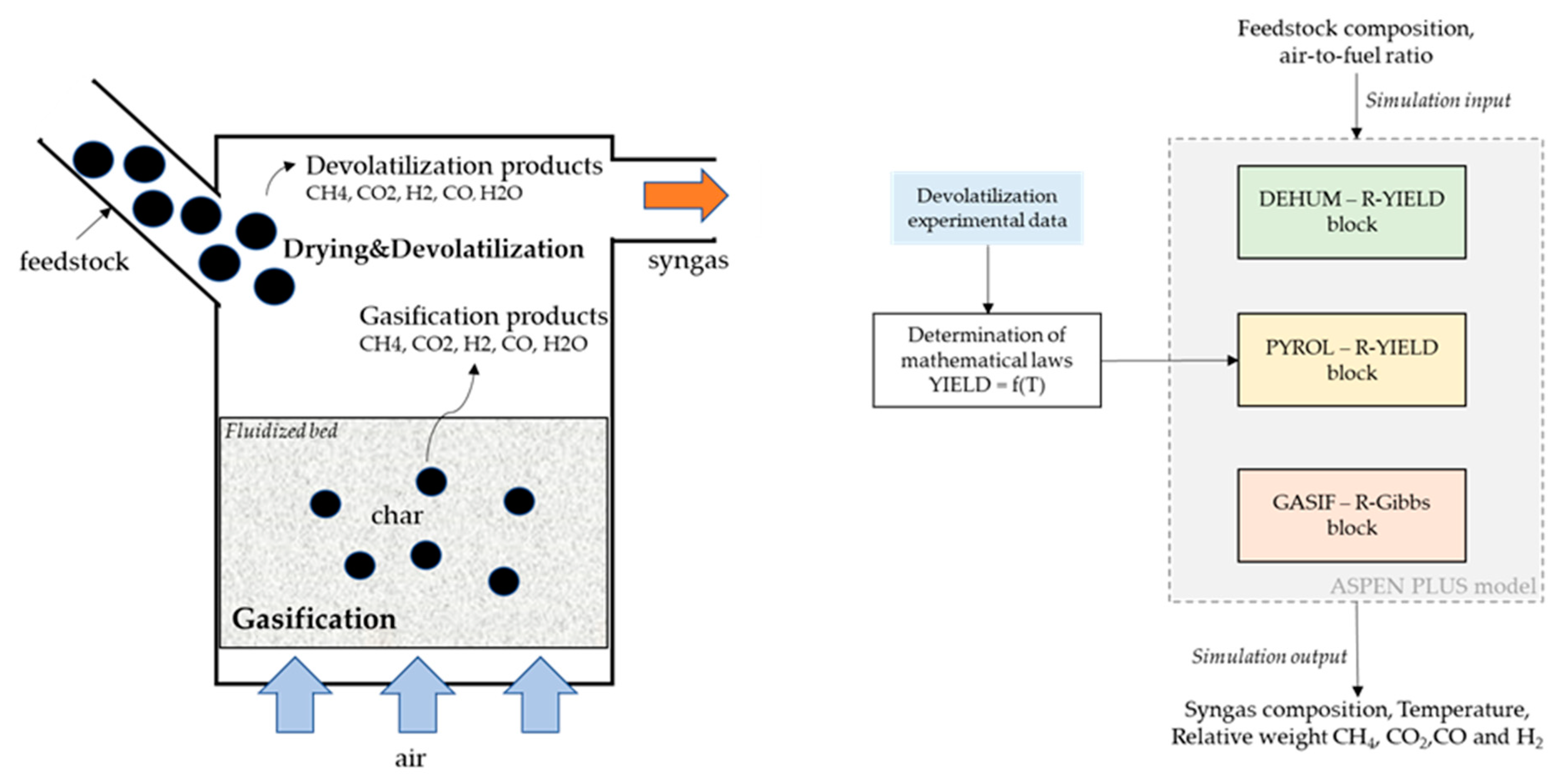
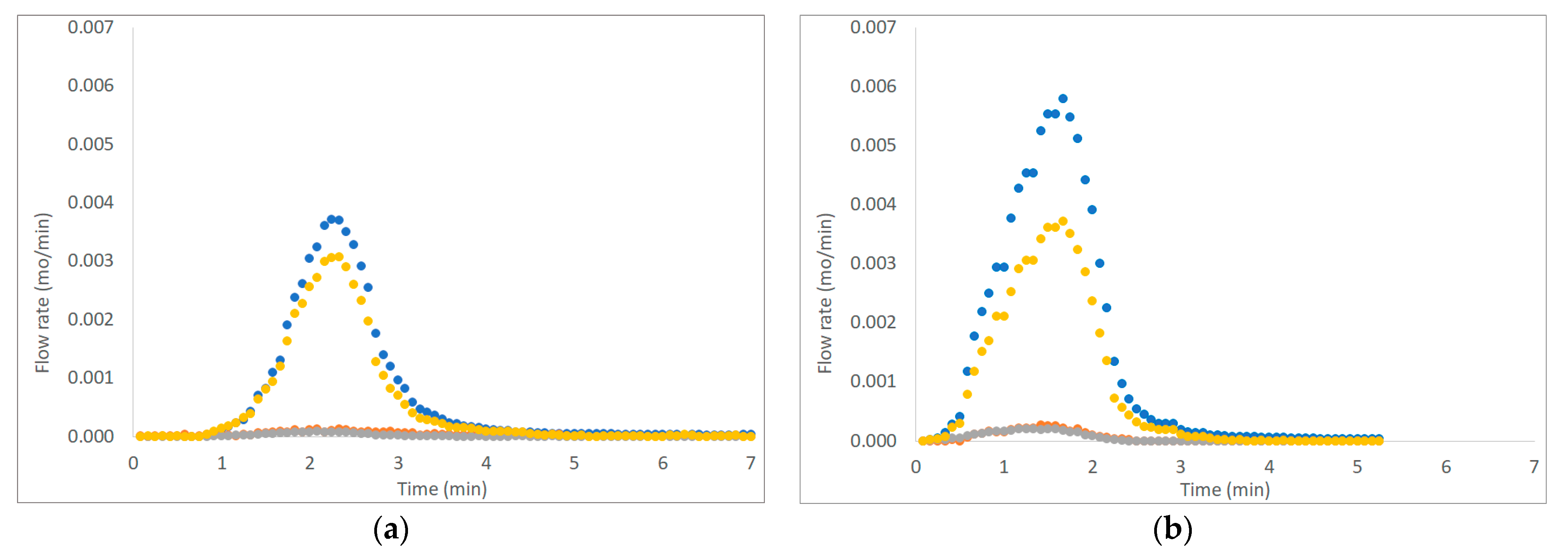
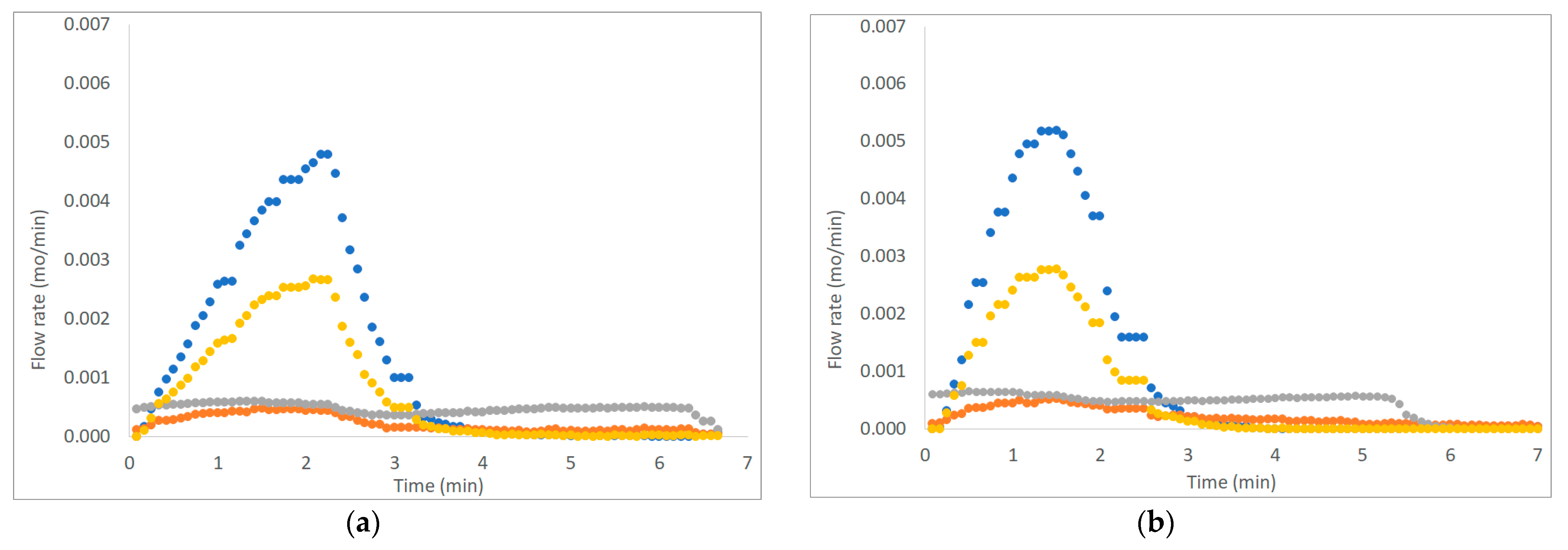

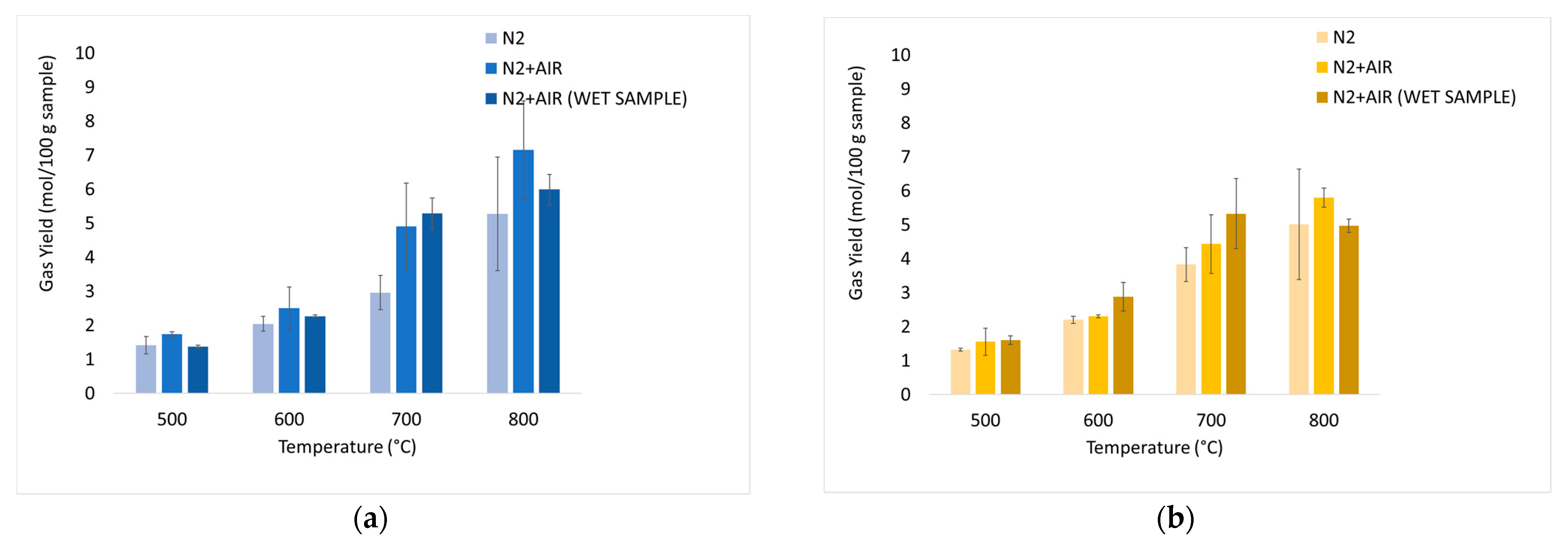

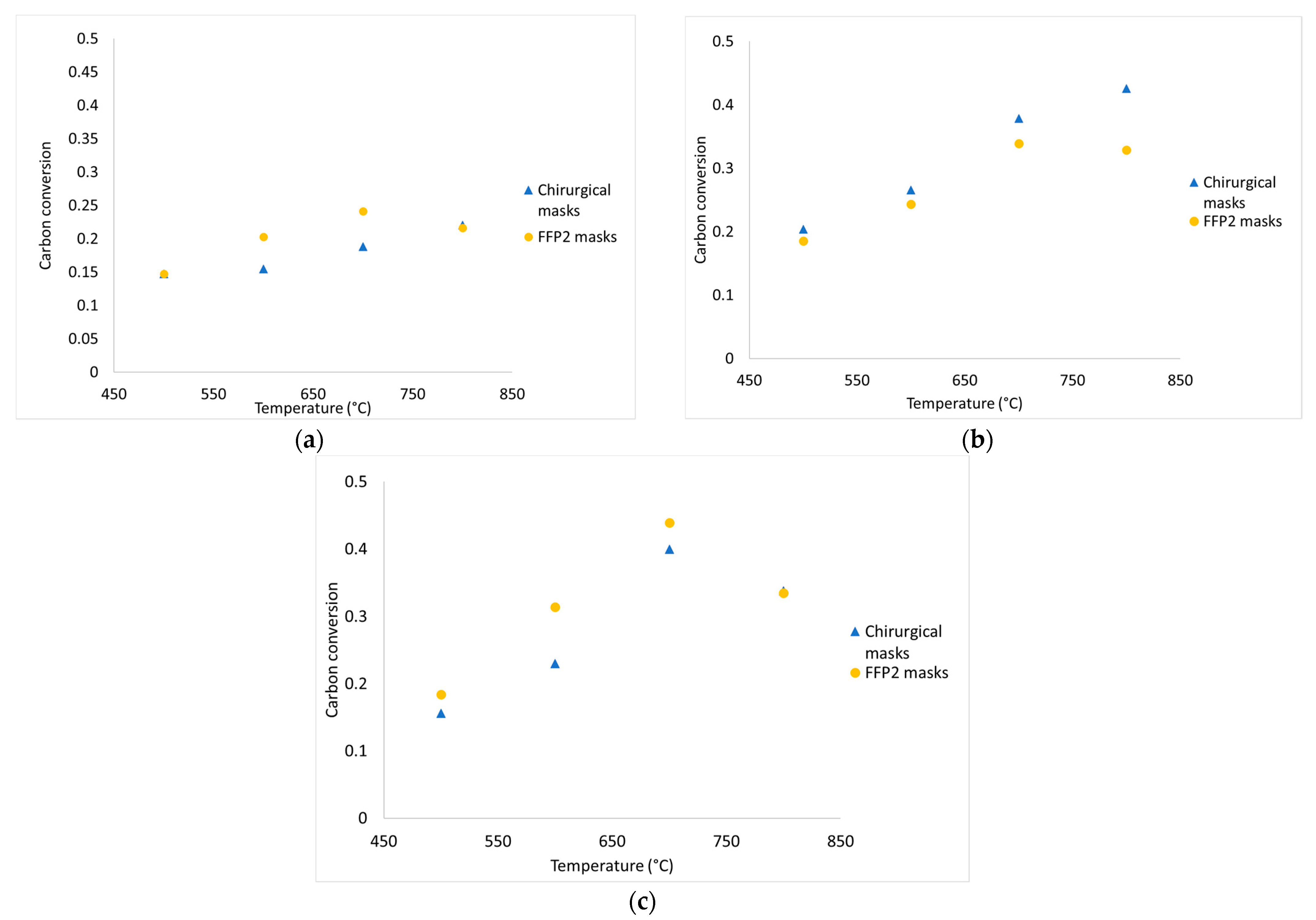






| Bed Material | Sand |
|---|---|
| dp (μm) | 212–250 |
| ρp (kg m−3) | 2587 |
| T (°C) | umf (cm s−1) |
| 500 | 2.9 |
| 600 | 2.7 |
| 700 | 2.5 |
| 800 | 2.3 |
| wt% | ||
|---|---|---|
| FFP2 | CHIRUGICAL | |
| Moisture | 0.97 | 0.58 |
| Ash | 0.91 | 0.62 |
| wt% | ||
|---|---|---|
| FFP2 | CHIRUGICAL | |
| Highly volatile matter | 1.2 ± 0.5 | ND 1 |
| Medium volatile matter | 95.9 ± 2.1 | 97.2 ± 2.0 |
| Combustible | 1.4 ± 0.4 | 1.3 ± 0.5 |
| Ash | ND 1 | ND 1 |
| wt% | ||
|---|---|---|
| FFP2 | CHIRUGICAL | |
| C | 82.34 ± 3.03 | 84.68 ± 0.29 |
| H | 7.44 ± 1.36 | 14.24 ± 2.76 |
| N | 0 | 0 |
| S | 0.81 ± 0.20 | 1.71 ± 0.18 |
| Element | wt% | Abs Err. 2 | wt% | Abs Err. 2 |
|---|---|---|---|---|
| FFP2 | CHIRURGICAL | |||
| Mg | 2.479 | 0.011 | 6.013 | 0.019 |
| Al | 0.000 | 0.000 | 0.240 | 0.000 |
| Si | 1.267 | 0.002 | 4.145 | 0.004 |
| P | 0.321 | 0.001 | 0.293 | 0.001 |
| S | 0.276 | 0.000 | 0.407 | 0.001 |
| K | 0.253 | 0.001 | 0.428 | 0.002 |
| Ca | 16.860 | 0.010 | 11.860 | 0.010 |
| Ti | 9.153 | 0.007 | 14.180 | 0.010 |
| Fe | 0.214 | 0.000 | 4.358 | 0.004 |
| Cu | 0.015 | 0.000 | 0.519 | 0.000 |
| Sb | 0.322 | 0.006 | 0.282 | 0.003 |
| Ba | 0.000 | 0.000 | 0.270 | 0.000 |
Publisher’s Note: MDPI stays neutral with regard to jurisdictional claims in published maps and institutional affiliations. |
© 2022 by the authors. Licensee MDPI, Basel, Switzerland. This article is an open access article distributed under the terms and conditions of the Creative Commons Attribution (CC BY) license (https://creativecommons.org/licenses/by/4.0/).
Share and Cite
Foffi, R.; Savuto, E.; Stante, M.; Mancini, R.; Gallucci, K. Study of Energy Valorization of Disposable Masks via Thermochemical Processes: Devolatilization Tests and Simulation Approach. Energies 2022, 15, 2103. https://doi.org/10.3390/en15062103
Foffi R, Savuto E, Stante M, Mancini R, Gallucci K. Study of Energy Valorization of Disposable Masks via Thermochemical Processes: Devolatilization Tests and Simulation Approach. Energies. 2022; 15(6):2103. https://doi.org/10.3390/en15062103
Chicago/Turabian StyleFoffi, Rachele, Elisa Savuto, Matteo Stante, Roberta Mancini, and Katia Gallucci. 2022. "Study of Energy Valorization of Disposable Masks via Thermochemical Processes: Devolatilization Tests and Simulation Approach" Energies 15, no. 6: 2103. https://doi.org/10.3390/en15062103
APA StyleFoffi, R., Savuto, E., Stante, M., Mancini, R., & Gallucci, K. (2022). Study of Energy Valorization of Disposable Masks via Thermochemical Processes: Devolatilization Tests and Simulation Approach. Energies, 15(6), 2103. https://doi.org/10.3390/en15062103









